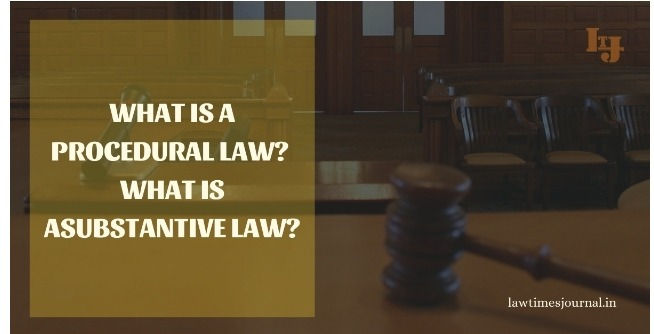
Lawtimesjournal
Law is a set of rules and regulations to run the country peacefully. These laws were mainly divided into two categories substantive law and procedural law, where substantive law deals with the right, liabilities and duties of a person against whom any wrong has been committed. Procedural law is procedure over the rights and liabilities.
Definition and meaning:-
Substantive law is a written law which has been passed by the Legislature of the country to set principles as to how one should behave in society. It deals with crimes and punishment under criminal law as well as under civil law, it deals with civil wrongs and liabilities. The substantive law protects the rights of an individual, or the individuals and state from wrong doer. Substantive law consists of substance having charges against the wrongdoer. One should be called convicted if he has proven guilty under the definition of crime in substantive law. To execute the justice under civil and criminal law, it will depend on the act and punishment prescribed under that offence in substantive law to maintain the socio-economic justice in the country.
Examples of substantive law are:-
Civil law:- Indian Contract Act, 1872, Sales Of Goods Act, 1930, Industrial Dispute Act, 1947, Hindu Marriage Act, 1955 etc.
Criminal law:- Indian Penal Code, 1860.
Procedural law acts as a machinery in the legal system and tells us about the procedure to the substantive laws and it regulates the proceeding of the court in criminal and civil cases. This law was based on the most important doctrine of 'due procedure of law ' which checks the fairness and reasonableness in the procedure of the established laws(substantive law). While proceedings in any matter in court should follow the procedure made under procedural law and if the court is not able to do so, it will be liable under the substantive law.
Procedural law can not be applied without substantive law therefore it depends on substantive law. Moreover, both the laws are interdependable over each one and cannot be executed in the absence of the other.
Initial step for any procedural law starts from investigation followed by enquiry and trial. When the judicial proceedings start, the court gives the summon notice to an accused which is followed by pleadings, proof, judgment and execution of the case.Therefore, procedural law determines the remedies.
Although in the case of Bharat Barrel & Drum Manufacturers Company Limited Vs Employees State Insurance Corporation, it was said by the Supreme Court that neither the substantive law is totally right nor the procedural law is totally remedial; both are interdependable on each other and both, substantive and procedural law are partially “right and remedies”.
Examples of procedural law:-
Civil Procedure Code, 1908, Criminal Procedure Code, 1973, Indian Evidence Act,1872.
In the case of Commissioner Of Wealth Tax, Meerut Vs Shravan Kumar Swarup &
Sons, Supreme Court laid down the difference between substantive and procedural law.[1]
● Substantive law tells the action and relation between the parties in relation to the subject matter of case. Whereas procedural law tells the action and relation between the court and the parties in the case.
● Substantive laws are the ends to administer justice where as procedural law is the means to administer justice.
● Substantive law separates the action as wrong and right whereas procedural law constitutes the steps after the action is defined wrong.
● Substantive law deals outside the court whereas procedural law deals inside the court.
Recently, the Delhi high court held in the case of NNR Global Logistics (Shanghai) Co Ltd Vs Aargaus Global Logistics Pvt Ltd, that law of limitations is a procedural law rather than substantive law.[2]
Footnotes
[1]-[2] https://lawtimesjournal.in/what-is-a-procedural-law-what-is-asubstantive-law /
References
(a) https://www.law.cornell.edu/wex
(b) https://thefactfactor.com/
(c) https://shodhganga.inflibnet.ac.in/
(d) 1972 AIR 1935, 1972 SCR (1) 867
(e) (1994)122CTR(SC)380
(f) [(2012 (8) AD (Delhi) 125)]
